Neil Peart's News, Weather and Sports
Bubba and the Professor
NeilPeart.net, February 12, 2014
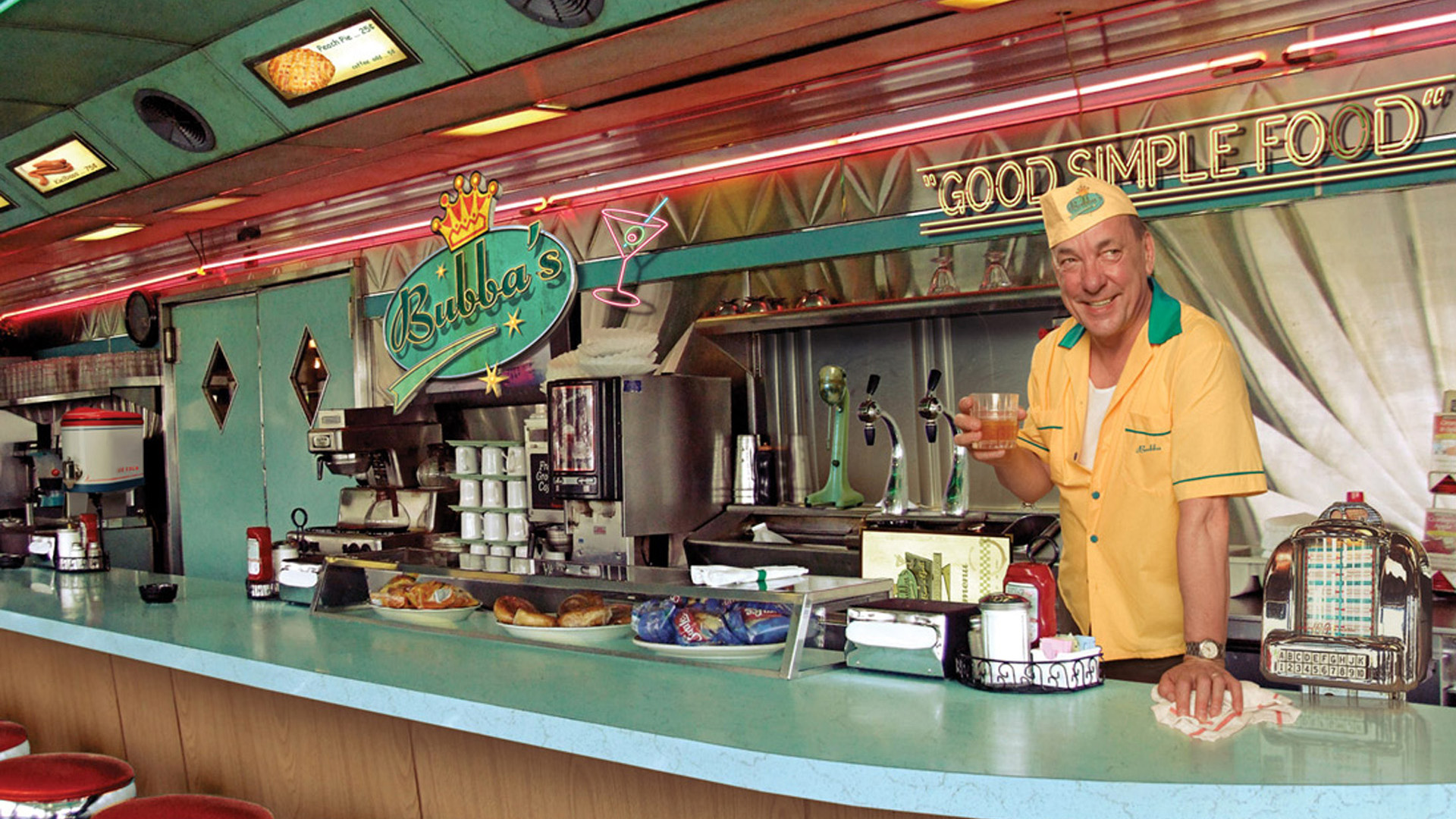
Can't you just picture the '60s sitcom, or wacky road movie, that would follow that title? Why, I can hear the theme music. The story would hinge on the classic "odd couple" setup, where a methodical, high-minded, would-be aesthete and intellectual is handcuffed to an easygoing neanderthal everythingaholic drummer.
You know, like the two polar sides of one character are tricked into sharing a long, difficult journey?
Oh wait - that's my life.
What tales our nicknames can tell. The two in this title have been conferred upon one individual - your reporter - at different times in his life. You may imagine they come with a story or two.
I often think back to a "road lesson" involving one of my oldest friends, Jimmy Johnson. He and I met around 1968, when J.J. joined my second band, the Majority (ha - our booking agency's genius slogan was "Join the Majority!"), as a "roadie." A few tumultuous years later (for both of us), when I joined Rush, J.J. became Alex's guitar tech for many years - many hilarious years. The two of them were a fine comedy duo.
(For the past couple of decades, J.J. has been performing the same job for Styx, and making them laugh, too, I'm sure.)
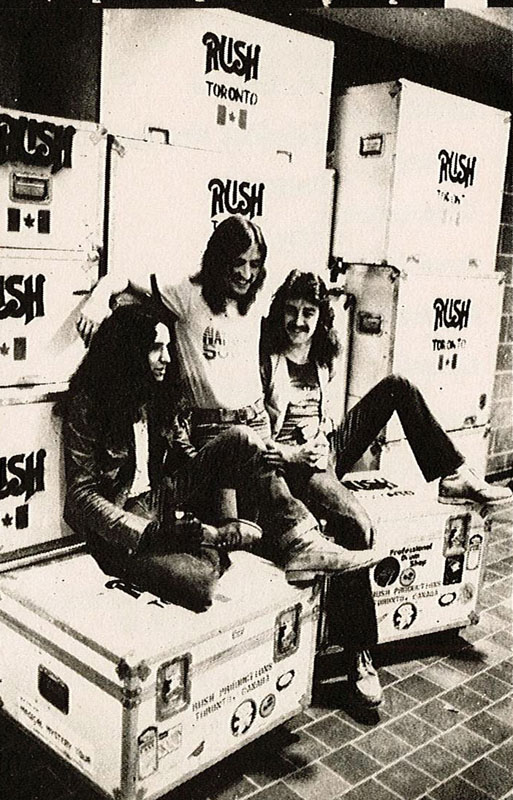 |
1974 Crew - Liam, Ian, J.J. |
But way back in the Olden Days (when dinosaurs walked the earth), in the mid '70s, Jimmy affected a mustache (as many of us did - I sported a full-on handlebar, myself). However, in the eyes of his fellow crew members, Ian and Liam, J.J. seemed to move beyond the pale when he started wearing a small scarf around his neck, knotted with a ring. They dubbed him "Tony Orlando," and the rest of us laughed and started using it, too.
J.J. blurted out a line that has resonated for decades. "But I don't want to be called Tony Orlando!"
Oh, we laughed and laughed.
Finally somebody put him wise, "You don't get to pick your own nickname!"
It was the same way with Bubba - I didn't pick it, and probably wouldn't have. It came from Andrew MacNaughtan, the band's main photographer from around 1989 until his tragically early death in 2011. During those years Andrew shot us casually and formally all over the world, including the portrait that opens this story (with expert Photoshop work from Hugh Syme), my all-time favorite. (Bubba's, anyway.) In the early '90s, Andrew also traveled with us on a couple of tours as a personal assistant. (Poor guy.)
Back in those days, early in a friendship that would deepen over the years, Andrew started calling me Bubba. Originally Southern slang for "brother," that title has grown to convey a "good ol' boy" stereotype - even "redneck." I could only assume Andrew was calling me that because I was pretty much the "Anti-Bubba" (I hope that's what he was thinking), because, you know, I had read books, and written them, and cared about art, and cooked for my family, arranged flowers, and was friends with gays and brown-skinned people.
(That duality amused me when I named "Bubba's Book Club," for example - a counterpoint to Oprah's. Later, the invention of "Bubba's Bar 'n' Grill" merely aimed at teaching other Bubbas how to cook "Good Simple Food.")
An even earlier nickname given to me, "The Professor," had an an equally ironic root. It was not, as many strangers assumed, some reflection of admiration from the Guys at Work for my intellect and learning. Oh no. Nor did it reflect an actual university degree, as some rumors held. No, the Guys at Work were simply equating my demeanor with the character on "Gilligan's Island," played by Russell Johnson.
Not terribly insulting - but not exactly cool, either.
(In the middle of writing this story, Russell Johnson suddenly appeared in the news, because he had died. However, he was 89, so not a bad run. And for almost fifty years his only real claim to fame had been that role as "the Professor" - he had "dined out on it," as the Brits would say.)
The screwball sitcom "Gilligan's Island" only aired for three seasons in the mid-'60s, but for decades after it was widely syndicated. During the show's first season, Professor Roy Hinkley, Ph.D, was not even included in the opening theme song - the five other characters were mentioned by name, but he and Mary Ann were lumped into "and the rest."
(Bubba suggests that our sitcom should be retitled, "Bubba...and the rest."
The dry-humored Professor sniffs, "Hi-lar-ious, Chucklehead.")
Early episodes revealed that the Professor was a research scientist and "well-known Scoutmaster." (I do hope that wasn't a veiled stereotype inserted to explain his seemingly "unnatural" lack of interest in sultry, sophisticated Ginger or sweet, virginal Mary Ann.) Cynical viewers have long noted, "Isn't it odd that the Professor could make a radio out of a coconut, but couldn't fix a hole in a boat?"
So...a question arises that has honestly never occurred to me before: which is the "real me?" The Professor, or Bubba?
Whoa. Perhaps that duality is like what a writer for Spy magazine once described as a metaphor of morality for people who grew up in the era of Disney cartoons: Above one shoulder is the "Good Goofy," an angel, and above the other is the "Bad Goofy," a devil. (Though Bubba is not really a devil, and the Professor is certainly no angel.)
The Bubba side of the doppelgänger, as he is shown above, would surely say, "Let me pour you another drink and we'll talk about it. Have some laughs."
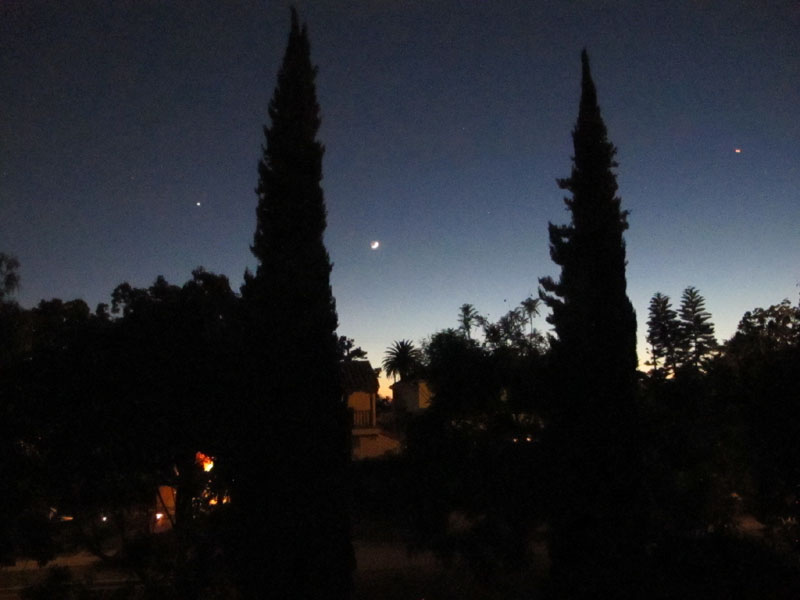 |
Bubba's California Twilight [Inspiring an Accidental Poem By the Professor] Venus, cypress, crescent moon with earthshine Royal palm, fan palms, Norfolk Island pines |
But the Professor would cut in, "No, no, that won't do. We are on sabbatical. We have to achieve something."
Ah, sweet sabbatical. The Professor's first intention was to begin this story with a rumination on that subject - wanting to open with the above night sky and spontaneous couplet. Bubba wanted to call the story "Black Sabbatical" - because that made him chuckle.
However, that title was ultimately doomed to fail, simply because there was nothing dark about that time - quite the opposite. Even in December, the California night sky sparkled with light and hope, and we can think of few times in our life that have been brighter. ("Some days were dark; some nights were bright.") But somehow "Golden Sabbatical" didn't make Bubba smile the same way.
Later, when the Professor pitched his "high concept" for the "Bubba and the Professor" sitcom, Bubba could only agree.
However, it turns out the words "sabbatical" and "sabbath" do have similar roots. An ancient Hebrew word (yes, Shabbat) means "a ceasing." The worthy Wiki gives us this nice clarification:
"In recent times, 'sabbatical' has come to mean any extended absence in the career of an individual in order to achieve something. In the modern sense, one takes sabbatical typically to fulfill some goal, e.g., writing a book or traveling extensively for research."
Oh yes, that works for us. Again we offer our definition of the perfect life: "a working vacation." As we happen to be taking an "extended absence" from our career, and aim to spend that time well, the truly key words in that definition are: "in order to achieve something."
Well, yes. That's the difference between a sabbatical and a vacation - something more like recreation than rest. (Though rest is nice, too, of course.)
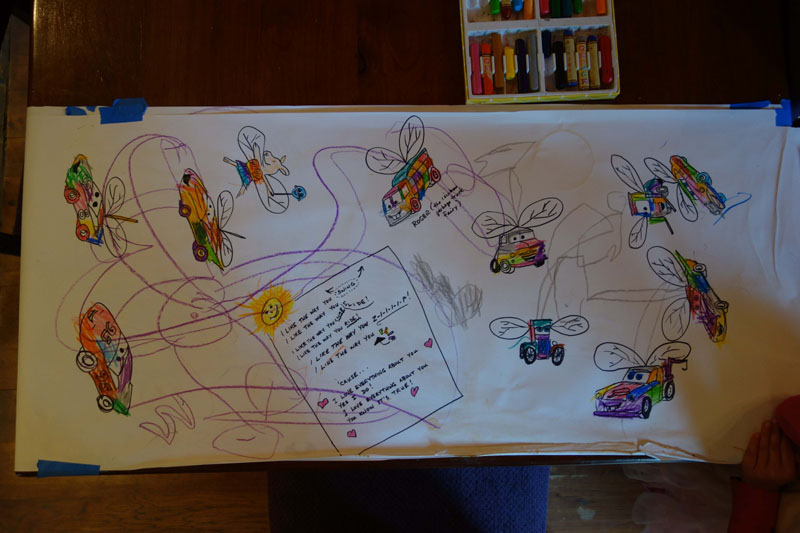 |
Art With Olivia |
"Traveling extensively for research" takes on a different meaning when your work involves traveling extensively. We were thinking of something more like "Staying home extensively for research."
"Achievement" can be broadly interpreted to include spending time with our four-year-old daughter, Olivia. Out of the many church signs we have collected and held up for ridicule over the years, a vanishing few have reflected the kind of deep, ancient wisdom that transcends faith and offers timeless human truth.
"How Does a Child Spell Love? T-I-M-E."
Bubba and the Professor always try to remember that. At some point in every day we are summoned to be the "quick sketch artist" for Olivia's fantastic visions. She will announce, "Mater, I want you to draw something." (Yet another nickname! After the Bubba-like tow truck in the Cars movies, voiced by Larry the Cable Guy. We won't go too deeply into that.)
Fetching our Sharpie, we sit on the floor by her little work table, and roll out a fresh sheet of paper, then stick it down with blue tape. Olivia describes what she wants - in this case, various characters from the Cars movies as "rainbow fairies," including one of her own invention called Roger the Rainbow Garbage Truck Fairy. (Ha - Pixar never thought of that.) A couple of the cars had to have dipstick-shaped headgear, like Dipsy from "The Teletubbies." (That's where the laughing sun comes from, too.) Olivia the pig dances ballet in the air, wearing mermaid shells, fairy wings, and a wand shaped like Mator, the UFO in Mater's Tall Tales. Because, well - obviously!
It's Olivia's world! We just live in it...
Olivia dictates every detail as she envisions it, every facial expression and gesture. We draw what she directs as closely as we can, then she colors it in. Here Olivia has also added "zoom lines," some Joan Miró swoops, and Cy Twombly-style decorations.
In the middle we printed a new verse for a song we had been working on, "I Love Everything About You," so we wouldn't forget it. We already had two verses and a chorus, and it was certainly one of our finest collaborations.
In a medium swing feel, the first verse went like this [with accompanying choreography]:
I like the way you think [point to temples and sing cymbal ride, 'ding-de-ding, ding-de-ding']
I like the way you talk [make hand puppet talking]
I like the way you da-a-a-ance [add frantic choreography]
I like the way you walk [add walking fingers]
I like the way you si-i-i-i-ing [falsetto long and loud!]
I like the way you do...[shrug]... everything
'Cau-au-ause [long rising note, over tempo shift to medium shuffle]
I love everything about you
Yes I do
I love everything about you
You know it's true
(Unfortunately, we realized later that the chorus melody echoes "Tell Him," by the Exciters - "I know - something about love" - from 1962, so we'll have to adjust that before we start recording.)
Then into the second verse, back to the medium swing feel:
I like the way you count [two, three, four, five]
I like the way you spell [a, b, c, d]
I like the way you bou-ou-ounce [jump up and down three times saying 'boing, boing, boing']
I like the way you...[long sniff]...smell
I like the way you ru-u-u-un (dash quickly around the kitchen counter]
I like the way you have fun -
[Repeat chorus]
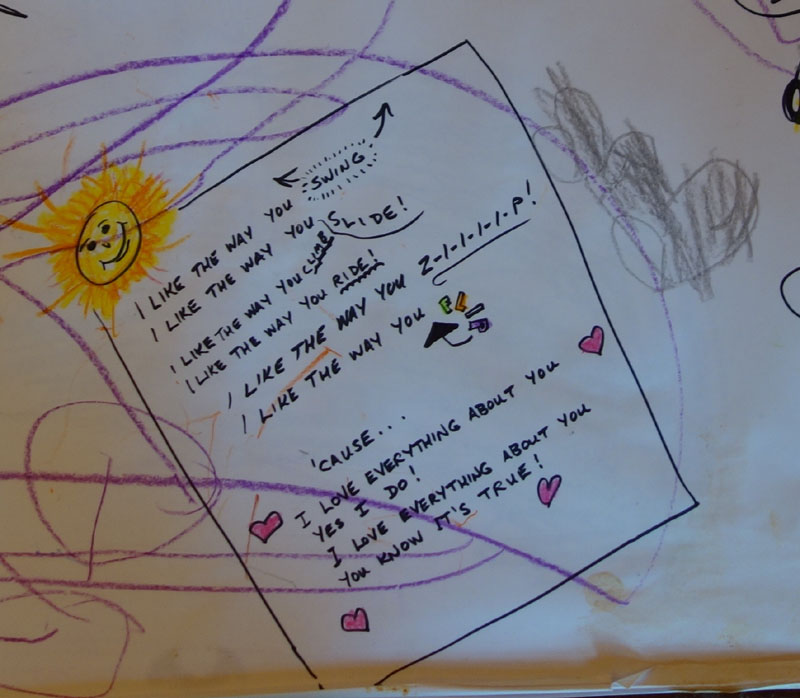
That October day, we worked out the third verse, while refining our graphic arts. All through the later months of 2013, and into 2014, our sabbatical time included that kind of "creative play."
Looking forward to our sabbatical year, and gradually formulating our goals, in early January we outlined our plans for what we hoped to achieve, in a letter to our friend Craiggie. He only lives across town in South Pasadena, and we had seen him just a few days before - with our families, attending "Bandfest," as we have for the past three years. (A few days before the Rose Festival parade, selected marching bands from around the world perform on a football field. Many of the bands, with dazzling costumes, spinning flags and batons, and nimble footwork, create a wondrous combination of music and choreography that is much more artful than they can deliver "on the march," as it were.)
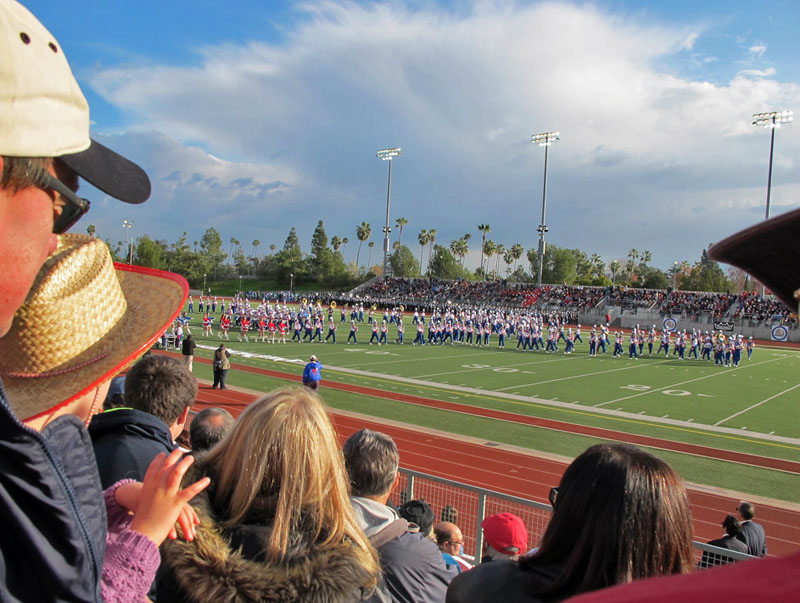 |
Watching Bandfest |
Like many of our friends, and ourselves, Craiggie writes long old-fashioned letters. Often these are employed as "sounding boards," when we're thinking something through for ourselves.
("How do we know what we think until we see what we write?")
Here is part of what we wrote to Craiggie that morning, "at the gate of the year," describing our hopes for a sabbatical 2014.
This isn't a time to "do nothing," but quite the opposite - a precious opportunity to do different things.
Work has been going forward on the Clockwork Angels graphic novel, and I'm getting pretty excited about it. I have been drawn into being more involved with the project, especially the artwork, loving the opportunity to see my vision of Crown City and the steamliners portrayed. (That's where we are so far, in the first "issue.")
The live-show rear-screen stuff was much more generic steampunk, sometimes of the more dystopian genre, which is opposite to the truly fantastic and rather splendid way I see Albion, with the darker scenes to come in Poseidon - "on the waterfront."
(Did you know Poseidon was the mythical capital of Atlantis? That's why I liked giving it the darker spin, an outlaw port full of scoundrels and misfits.)
The rear-screen stuff is not my department, and I can't supervise everything, so I just let that go. Hugh's artwork was always totally in sync with my vision, and now this is a chance to really nail every detail of the different settings.
The artist, Nick Robles, is quite excellent, at both characters and outlandish architecture, and takes "direction" well. Kevin [Anderson] is writing the script - I am surprised to learn that he basically maps out the whole thing, panel by panel, even dictating their relative sizes, and the artist "just" fills them in.
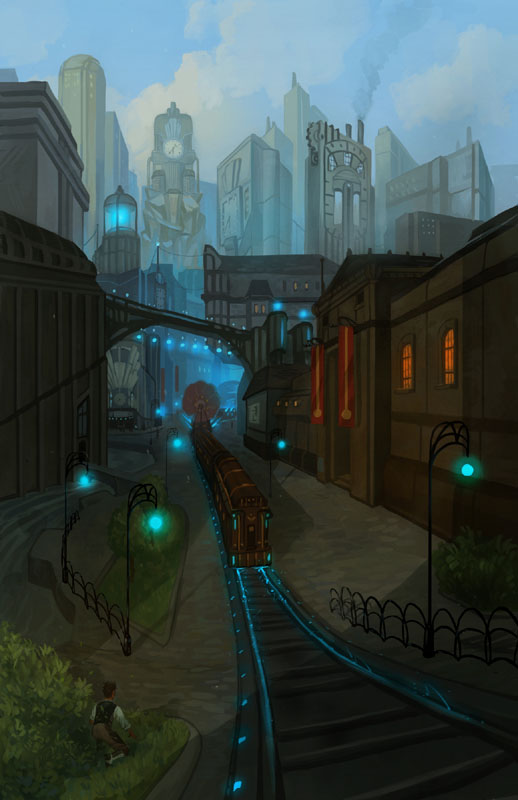 |
Owen Arrives in Crown City Art by Nick Robles |
Interesting that Nick has previously been most active in "hard" sci-fi illustration, and later admitted he wasn't that familiar with the steampunk aesthetic. Thus his first renderings of Crown City were much more generic - the typical setting that resembles Victorian London. Oh no, not my Crown City! It is something entirely more monumental and fantastically exotic. I had to steer him back toward the "grandeur" of sci-fi cityscapes, something more awesome, spacious, and - yes - Utopian.
Then I'm thinking it's time to publish another collection of stories. Although the title of the calendar was conceived only for that purpose, I'm starting to like it for a book. Maybe Far and Near: On Days Like These.
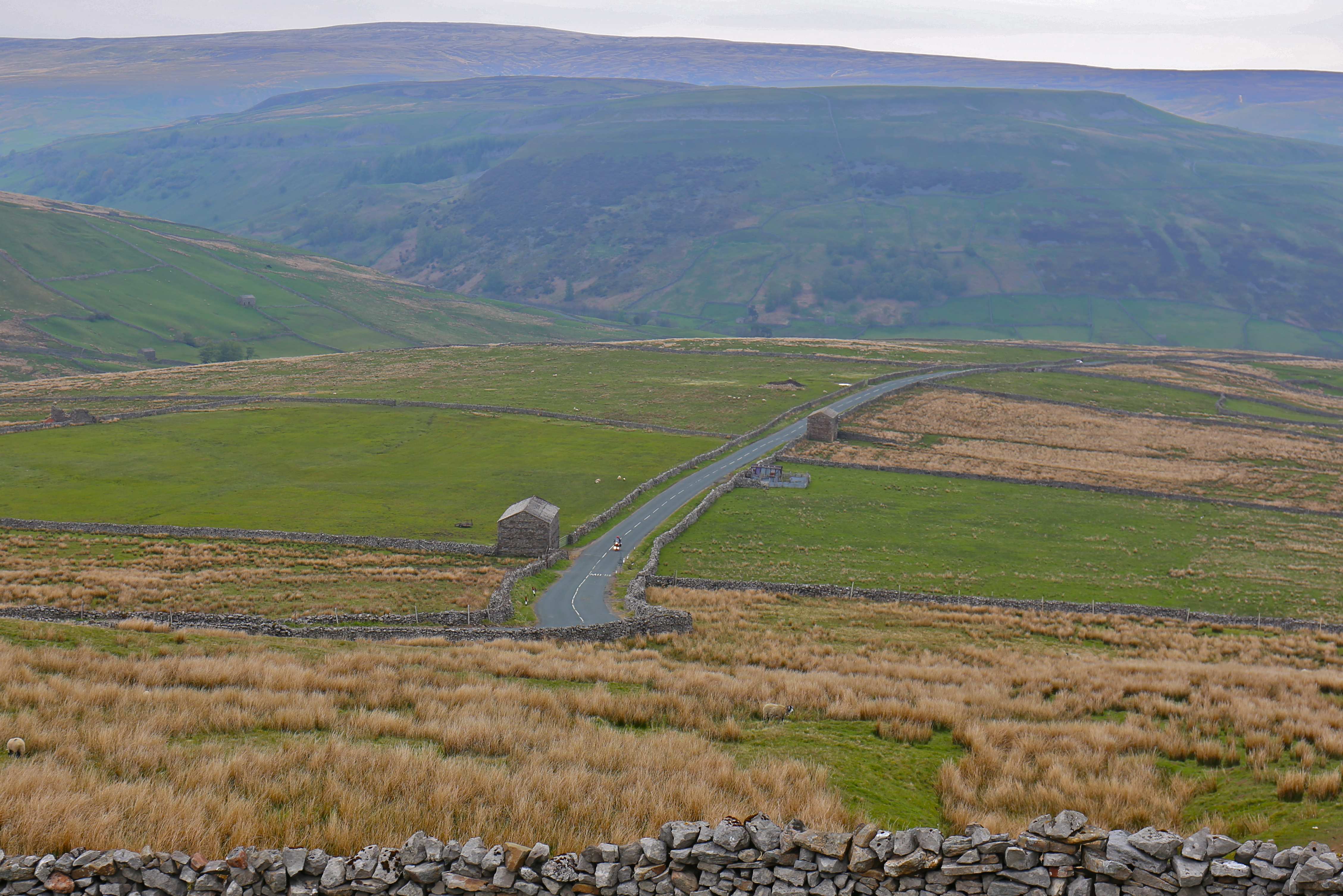 |
North Yorkshire Moors - Bubba at "Center Stage" |
The cover image in my mind is still that North Yorkshire one, so that would work. (One thing I loved right away about the title "On Days Like These" is that it works for every image, and every day!) Then a variety of scenic photos on the back, as in Far and Away, to suggest the extent of the settings within.
I would like to collect one more story, maybe of February in Quebec (a recurring theme!), then would want to write new intro and outro pieces for it.
Putting together a book, even of existing stories, is no small undertaking, collecting all the elements for publication, supervising the layout and proofreading, and preparing all the "ancillary" material - the "front matter," they call it.
However, it is certainly rewarding to hold the finished product in your hands - and send it to all your friends!
A proper sabbatical year should include both other modes of study, and travel (for "research"), and a chance to delve deeper into your own "specialty" - in my case, hitting things with sticks. I have already talked with Peter Erskine about working with him again, maybe around springtime. Something worthwhile is sure to come out of that...
All of a sudden today I am jonesing for a long motorcycle ride. Over the past few months I kind of consciously put that aside, deliberately wanting to make everything about my everyday life different, and give the usual daily activities in my recent life - drumming and motorcycling - a rest.
That has been good, but this morning as I backed the car out of the garage to head for the Y, I glanced at my shiny red GS sitting there, and - a spark went off in my brain.
Probably in the so-called "reptile brain," a pre-literate grunt, "Want. To. Ride."
So I'm letting that desire float up into the higher levels of cognition, to figure out how to satisfy that primitive urge in some creative way.
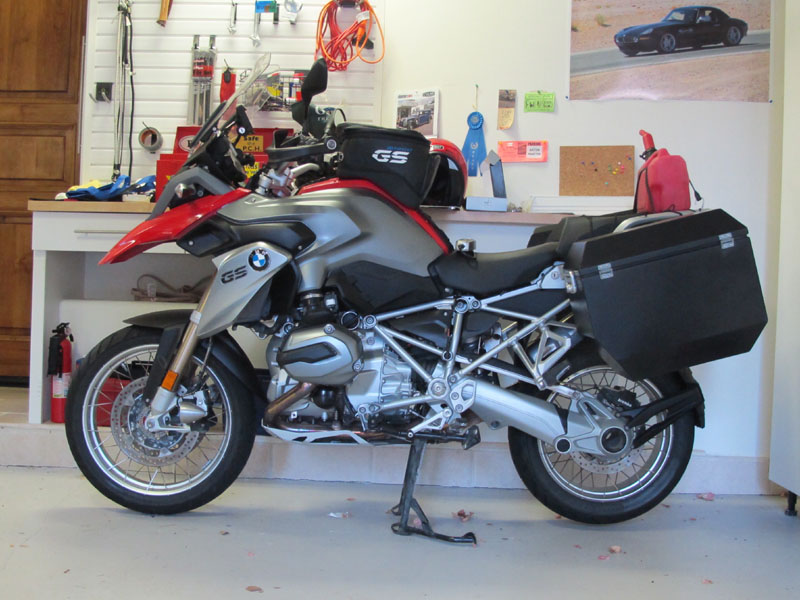 |
The Faithful Steed Awaits |
At the time of writing that letter to Craiggie, we hadn't yet had the divine inspiration for "Bubba and the Professor," but that final passage is definitely a perfect example of how we work together. Bubba has an urge; the Professor finds an intelligent way to scratch it.
The Professor was busy with his own itches in late 2013, because one unexpected achievement was an outpouring of "educational" writing. (The quotes seem necessary, because that quality can only be hoped for, not assured.)
First a British drum magazine asked for some thoughts on our solo excursions on the Clockwork Angels DVD.
(They seem to have choked on the carefully wrought 4,000 word response, for we've heard nothing back from them!)
Then the author of a book called something like By Drummers For Drummers asked for some thoughts on recording. Perhaps a book will be a more suitable medium for the 4,000 words we gave him - though we haven't heard back yet.
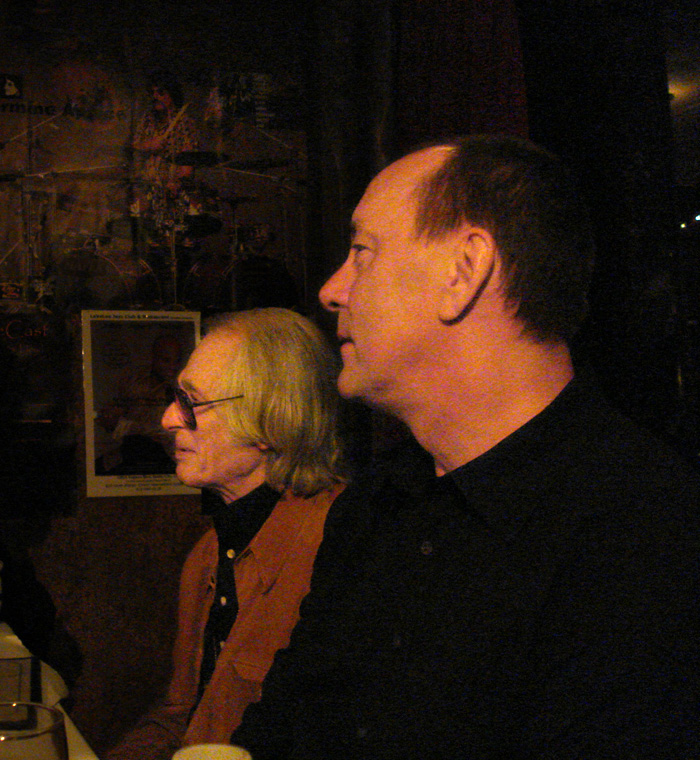 |
Freddie and Me (Us) at His 80th Birthday Party, 2007 Watching Joey Heredia Play |
A music scholar contacted us about a "senior comprehensive research paper" he was writing on the teachings of Freddie Gruber. He sent us a detailed questionnaire, which Bubba insisted we ignore, and we proceeded to tell the story our way - improvising around the questions in a way similar to the way we describe practicing in that essay: Just start playing, and work the exercises into whatever the day's "story" becomes. So we sent him about 3,000 words on that worthy subject - no word back on that one, either.
But never mind - we'll find some place to publish it, for the excellent cause of keeping Freddie's memory, and his teachings, alive.
All of that writing kept the Professor fairly busy, while Bubba played with his cars.
On the subjects of soloing and recording, and studying too, we realize that we have been preoccupied by all of those pursuits for over forty years - so we have a great number of experiences, and a little advice, to share. And given the time - a sabbatical time - it seemed worth doing.
Truth be told, that kind of writing is not as entertaining or rewarding as these little "open letters" always are - no pleasure of reading them over at the end of the day with a double-old-fashioned glass clinking with ice and amber nectar. (A true Bubba-meets-the-Professor moment if there ever was one!) There are no surprises from a day's work, like the unexpected directions "undisciplined" writing can reveal. Those technical essays were more of a chore, and were simply "worth doing." Still, we couldn't help chipping away at those tasks with the approach to work and life drilled into us early by our father.
"If a thing is worth doing, it's worth doing well."
Bubba chimes in with a snort, "You mean, it's worth beating yourself up day and night trying to get it right!"
The Professor adds with a dark laugh, "And worth beating yourself up about forever after - because you didn't get it right."
But that's just me.
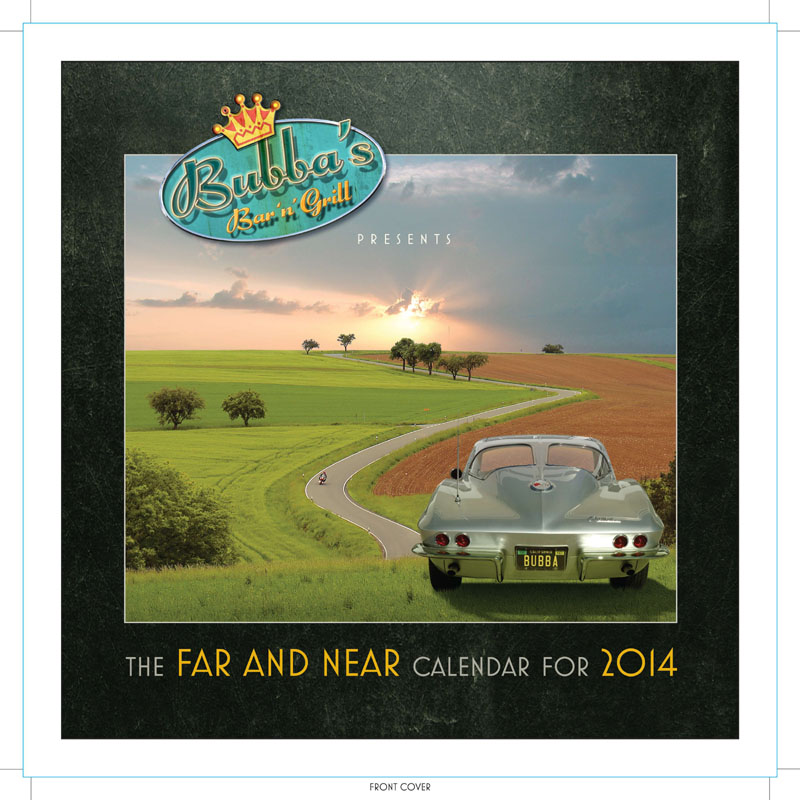
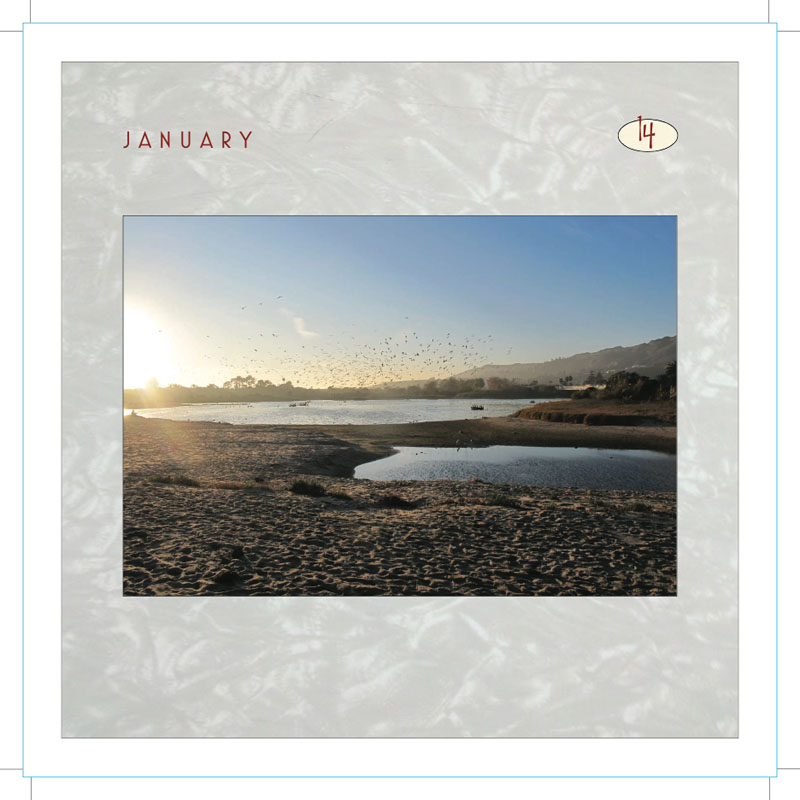
I mean, him...
A more creative and satisfying undertaking for both Bubba and the Professor was putting together a new calendar for Bubba's Bar 'n' Grill - something they could both get their teeth into. As we have noted before, few activities are as enjoyable and rewarding as making things - meaning things you can hold in your hands, with pride, and even look at on your wall all year, with pleasure. (Bubba and the Professor agree that pride and pleasure are a good combination. Both in moderation, of course. We are Canadian.)
Back in the autumn of 2011, we had a little time at home, and a little ambition (sometimes a great combination), and with our lifetime art director, Hugh Syme, put together the first Bubba's calendar. We were sure we had created something beautiful, entertaining, cool, and affordable - surely everyone would want one, and to buy lots more for their friends at Christmas.
But alas, sales were disappointing - we gave away more copies than we sold. The world let us down again. (As it still does often enough to keep us humble...)
The following autumn we were out on the Clockwork Angels tour, so didn't have the leisure to try to match the first calendar's combination of carefully chosen images and text blocks. However, this past September we were just settling into our sabbatical frame of mind, and were inspired to try another calendar. Brother Danny, who has been our prose editor for the past couple of years, helped in selecting the images and text passages, and once again Hugh Syme stepped up with a brilliant design.
The front cover combined a "far and away" shot taken by Brutus in Germany (I titled it "Der Zigzags"), with Hugh's additions of a more dramatic sky, and the shapely rear of Bubba's 1963 Split-Window Corvette.
On the back cover, we were delighted to have another chance to present that all-time favorite portrait - or at least Bubba's favorite - the one that opens this story.
Nice things happened to make this calendar rewarding. One day in October I was visiting Don Lombardi up at Drum Channel, and mentioned that I had put the calendar up for sale online, but early orders were disappointing. As a good friend and booster (and the founder of Drum Workshop), Don immediately picked up the phone and called the president of Guitar Center - a chain of almost 300 stores around the United States that sell musical instruments. After some consultations, they eventually agreed to order 1200 calendars to spread around their stores. The bad news was that the price would not be enough even to match my costs, and they are on a "sale or return" basis, so I will see an unknown quantity coming back. But never mind - at least people would have a chance to find them.
And there were other rewards - many grateful recipients of the copies I sent to friends wrote to thank me. One day I received a note from Jamie Borden, who combines the unlikely Vegas careers of dedicated cop by day, and passionate rock drummer by night. (I smell another sit-com!)
Jamie told me he had arrived home from a trip just before Christmas, and found his whole extended family baking up a storm, with decorations everywhere, and his home filled with every true spirit of the season. Amid all that, he opened our calendar and went through it, describing to his loved ones what he knew about the stories behind the images, and reading some aloud.
Naturally, that was exactly the kind of heartfelt appreciation from a dear friend that could make the project feel entirely worthwhile.
In a letter (probably to Craiggie) just after Christmas, we were reviewing that hectic season, the three weeks we had dedicated to shopping for gifts, getting them shipped, planning menus for Chef Bubba, shopping for groceries, and cooking for large gatherings on Christmas Eve (ten guests) and Day (fifteen - with a Flintstones-sized turkey).
We concluded with what felt like the "score."
"Me: Grateful.
Others: Grateful to me."
That seemed like a fair result.
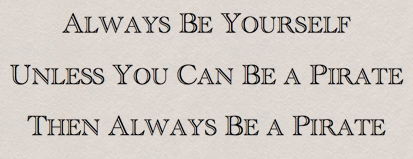
Okay, that surreal segue comes with a smile, and courtesy of friend Craiggie. It delights us to imagine it on a sign in front of a church.
As a career choice, piracy didn't work out for us (too much competition, these days!), so we're going to keep on being Bubba and the Professor. (Not that we have any choice.)
Fortunately, one thing we do have in common is that both of us like road trips, the longer the better, on two wheels or four. In early January, wife Carrie expressed interest in a two-night family trip to San Francisco, wanting especially to see the David Hockney exhibition at the de Young Museum. While the girls preferred to travel by air, Bubba and the Professor willingly chose the 850-mile return drive in their Aston Martin Vanquish. Interstate 5 is typically the quickest way north, by an hour or so, but California 101 is more scenic and "characterful." Best of all, if time permits, there's Highway 1 between San Luis Obispo through Big Sur to Monterey - one of the world's greatest stretches of road.
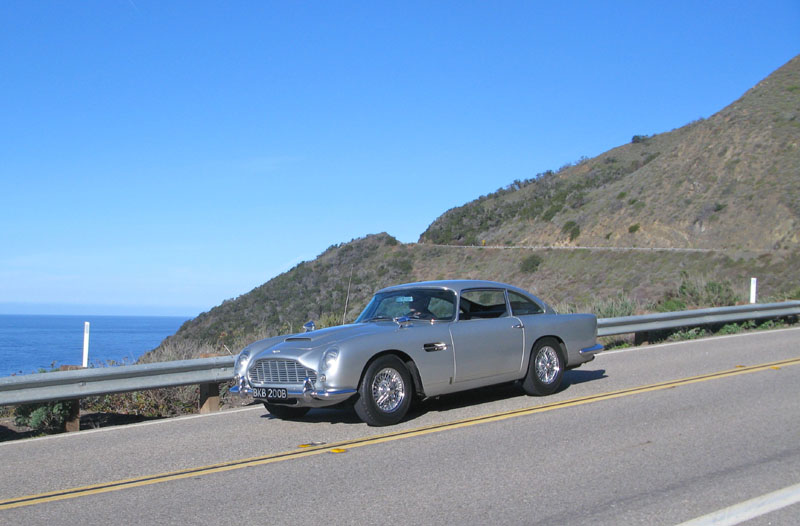 |
The Professor's DB5, Pacific Coast Highway - 2008 |
However, that route pretty much demands an overnight somewhere along that sublime coast, so this time we would be satisfied with six hours or so on 101, to get to the hotel in San Francisco before the girls. No problem. Leaving in the pre-dawn darkness and heading up the coast as the sky pearled into light over the calm Pacific, the miles passed pleasantly. North through Ventura, Santa Barbara, and San Luis Obispo, we decided to pause for lunch at the In-N-Out Burger in Salinas (John Steinbeck's hometown, with its "National Steinbeck Center," described in Ghost Rider).
In that midwinter season, the hills of Central California should have been velvety green from the winter rains, but they wore their midsummer brown (what I once called the "lion-colored hills"), looking parched and shriveled. Through December and January we should have received much of a year's worth of rainfall - but there had been almost none. The drought in California was off the charts - not something like half or three-quarters, but a mere single-digit percentage of average amounts. The worst in recorded history.
In the Los Angeles Basin, the dreaded Santa Anas, or "devil winds," had been sweeping in from the high desert, growing hotter and drier as they descended. In a time of such drought, they vastly increased the danger of wildfires. A couple of bad ones had already flared up, and it was likely only the beginning of a dangerous season.
(Some wag once defined the four seasons in Southern California as drought, wildfire, flood, and mudslide. This year we were only getting the first two - so far.)
The smoke in the air also worsened the effects of the Santa Anas. In the opening of Traveling Music, we told about the unpleasantness of the devil winds - rasping in your sinuses, your throat, your eyes, your skin, and your mood.
In the novel Red Wind, Raymond Chandler defined the Santa Anas for all time:
There was a desert wind blowing that night. It was one of those hot dry Santa Anas that come down through the mountain passes and curl your hair and make your nerves jump and your skin itch. On nights like that every booze party ends in a fight. Meek little wives feel the edge of the carving knife and study their husbands' necks. Anything can happen.
The climate of the Bay Area, 400 miles north, was cooler and usually wetter - though they had their own "devil winds," the Diablos, from time to time. And their drought at that time was equally severe. A friend living in the nearby Santa Cruz Mountains told me they usually received 70 inches of rain - that year they'd had five.
During our visit to Tony Bennett's "city by the bay," we had cool, sunny weather, and all had a good time - a great playground in Yerba Buena Park for Olivia, and an unforgettable meal for Mom and Dad at Michael Mino's restaurant.
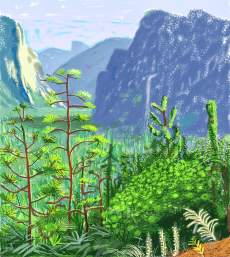 |
David Hockney, Yosemite I, October 16th 2011. iPad drawing printed on paper (6 sheets) |
And there was the uplifting experience of viewing "A Bigger Exhibition," a monumental installation of recent works (this century) by David Hockney. British-born (1937), Yorkshire bred, and a longtime resident of California, Hockney rose to prominence in the pop art school of the '60s, then grew into his own mature style of what Bubba and the Professor (amateur art critics who know the lingo) might call "representational expressionism." Over the years we had seen his work at the Tate Gallery in London, and at the Los Angeles County Museum of Art, and had always enjoyed it, in a "lukewarm" way. However, after viewing this exhibition, we came away convinced David Hockney is the greatest living visual artist - a worthy heir in skill, range, and vision to his self-described hero, Picasso.
The works on display at the de Young represented an immense variety and quantity of art - yet covered just over a decade, by an artist in his seventies. That alone was inspiring. Works were grouped according to medium, across the full spectrum of an obviously passionate, even obsessed graphic artist - entire galleries of charcoal sketches, watercolors, oils, acrylics, and color sketches created on iPads and iPhones. (He was quoted in one of the descriptions that the neighbors in his Yorkshire village jokingly asked if it was true he was making art on his mobile phone. He replied that no, he simply sometimes used his sketchpad as a telephone.)
Those creations were gorgeously printed out on scales ranging from small studies to multi-canvas assemblages that filled whole walls - overwhelming to stand before. Some of the combinations echoed his longtime cubist fascination - famously expressed during the '70s by collages assembled from multiple Polaroids and, later, high quality prints arranged to depict a fragmented, but entire view. He called them "joiners." We could see that approach echoed in more recent filmworks, in which he used multi-camera digital videos on gallery-sized grids of screens to show fragmented views of driving through a Yorkshire landscape, or of jugglers practicing.
Hockney's recent visual preoccupations were apparent in several series of portraits, and many vast landscapes of Yosemite and East Yorkshire. Being familiar with both of those areas, we could only wonder what the experience was like for those who weren't - did those great paintings evoke the same degree of appreciation if you hadn't seen the "source material" - the actual landscapes they attempted to capture?
Bubba opined, "Hmm, no - other folks just can't see it like we do. 'Cause we can say, 'That is exactly how a Yorkshire lane looks on a rainy day.' It's one thing to say a piece of art is beautiful, but a whole lot greater to say it's beautiful and true."
The Professor said, "Whoa, Bubba - you are deep today."
Early next morning, at 5:30, we were on the way back south from San Francisco. We drove through the endless dark suburbs to San Jose, then, as the red disk of sun inched up before us, into the farmlands of the Salinas Valley. We stopped in Salinas again, for breakfast at the Black Bear Diner, a Western chain of traditional small-town eateries with nostalgic décor, music, and menus. Always friendly and good, in our experience.
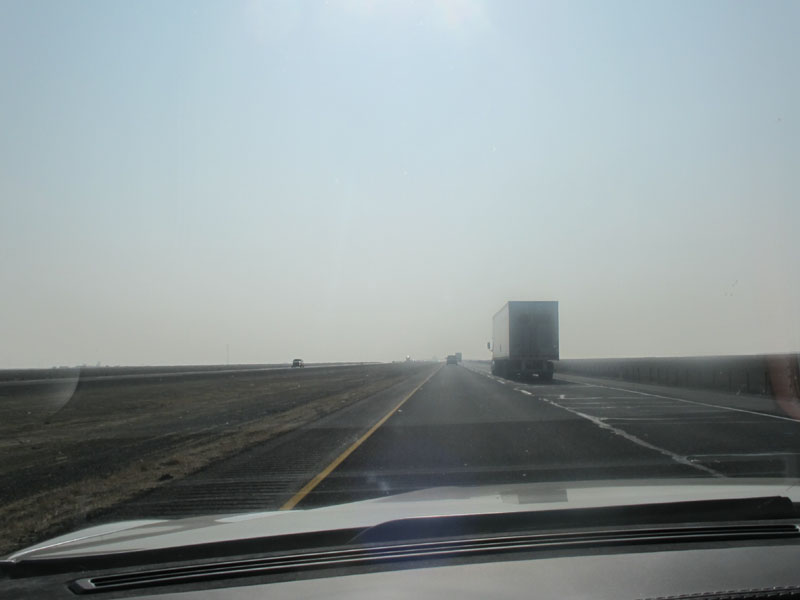 |
Interstate 5 Brown dirt, white sky |
(Roadcraft tip: As professional travelers, we have suffered more intestinal distress from undercooked eggs than any other cause. We love soft-boiled, sunny-side-up, and especially poached eggs, but we make those at home. When traveling, we recommend over-medium, or scrambled.)
Just over a week later, we set off on another long road trip, this time 500 miles north, to a dot on the map called Willows, California. This would be a different kind of "traveling extensively for research." Once again we started north along the dark coast through Malibu and Ventura County, then turned inland to Ojai, and one of our all-time favorite roads: California State Route 33. On two wheels or four, that little road has just about everything, and rarely do we share it with any other traffic. The first seventy miles or so are a looping, challenging delight, through the chaparral and pines of the Santa Ynez Mountains and Los Padres National Forest.
Up toward Maricopa the country flattens out into irrigated hayfields, then a long stretch of oilfields - the old-fashioned kind of "nodding bird" pumps. Somehow such an old-tech industry had a quirky charm, and certainly didn't blight that dusty landscape. No doubt the dreaded, more modern fracking is going on beneath the surface.
That stretch of Route 33 is not especially scenic, but the driving is fine, on a straight, empty two-lane. In good conditions, that kind of desert road can sensibly be driven at 80 mph - but of course the signs dictate otherwise. So we put up our radar detector, to stand guard against "surprises" from the California Highway Patrol. A speed trap was unlikely, but the odd time you might encounter a randomly patroling cruiser coming the other way. We hate that conversation.
The crossroads of Blackwells Corners has long billed itself as "James Dean's Last Stop." On September 30, 1955, while driving his Porsche Spyder to a racetrack in Salinas, he apparently bought gas, cigarettes, and an apple. A few miles farther on, at the intersection with California 46, he was killed by a Ford sedan, whose driver failed to see the tiny silver car in a glaring sun. Dean was only twenty-five - and none of the three movies that would make him an enduring legend (Rebel Without a Cause, East of Eden, and Giant) had even been released.
Around there, at the quaintly-named town of Kettleman City, we surrendered to the "mileage-disposal unit" - Interstate 5. We had covered half the journey, 250 miles, on the backroads, and now needed to make some time. We also changed defensive tactics: instead of the radar detector, we turned on the cruise control. In previous Roadcraft references, we have advised that speeding on American interstates is generally a losing gamble. Just set the cruise at an acceptable "eight over," and relax.
The above photograph of a bleak Central Valley interstate scene makes a good contrast to other images we have shown of "idyllic" California - the evening sky with palm trees, and the Coast Highway. In the heart of the Central Valley (which grows something like thirty percent of America's produce), the drought left the fields, leafless orchards, and hills nearby parched and brown. Occasional amateurish signs along the freeway pleaded "Stop the Congress Created Dust Bowl."
I knew those signs, and many others with similar messages, referred to the constant struggle over water rights in such "lands of little rain." In semi-desert regions like the Central Valley (all of Southern California, for that matter), the combination of unlimited sunshine with a supply of irrigation water was a treasure beyond price. As Mark Twain explained, "Whisky is for drinking. Water is for fighting over."
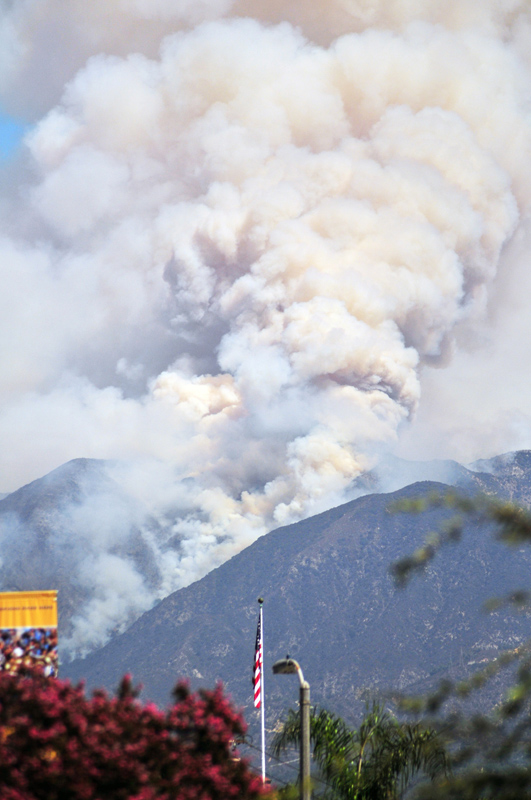 |
Pasadena Wildfire, 2009 |
As I cruised along I-5 at precisely 78 mph, I saw the farther hills on both sides, and the sky above, were ghostly white. That was the smoke drifting downwind from the big Colby fire, in the San Gabriels near Glendale - about 200 miles away. The sun burned through, but the light was harsh and glaring on windshields in the opposite lanes.
The brown, twiggy balls of tumbleweed that would usually cluster along the windward fences had been gathered into enormous stacks. That made a monstrous image of what they really represented - not a romantic symbol of the Old West, but an invasive species and pest. Like kudzu in the South, or purple loosestrife in the Northeast, tumbleweed is an alien invader, Russian thistle - thought to have arrived from that country in the mid-19th century with wheat seeds. Another monstrous presence loomed over a few enormous cattle feedlots, which give off one of the vilest stenches on earth. Driving by them on the leeward side, we try to hold our breath. Mile after mile, the overall impression was of a flat, arid, rather bleak landscape subjugated by vast factory farms and intricate irrigation canals.
Still, it was what it was, and for us, the drive was a perfectly enjoyable way to spend a day. Traveling for research. And the destination was inspiring, too - Thunderhill Raceway, for the next day's Aston Martin club trackday. A racetrack is where a car like the Vanquish can properly "express itself," of course - not on a freeway or suburban boulevard. (Not that it isn't nice to drive there, too!) On winding roads along the coast or in the mountains, and on racetracks, the car has a "sporting" character, powerful and responsive. Yet it also excels as a "grand tourer" - after a 500-mile drive, we climb out feeling fresh and free of pain. A little bleary-eyed and stiff, of course, but not hurting anywhere. When people ask us what the Vanquish is like, we simply reply, "It is everything it ought to be."
Our friend Matt Scannell once said he liked how when a stranger looked at one of our cars admiringly, and described it as his (and sometimes her) "dream car," we would simply say, "Mine too."
Because of course these are all our dream cars, and Bubba and the Professor both admire them and use them - long journeys and racetrack outings for the "modern supercar," and plenty of backroad exercise for the "classics." (We have put over 20,000 miles on the DB5 alone, in six or seven years - which included long absences while touring and recording, and a year off the road for a mechanical rebuild.)
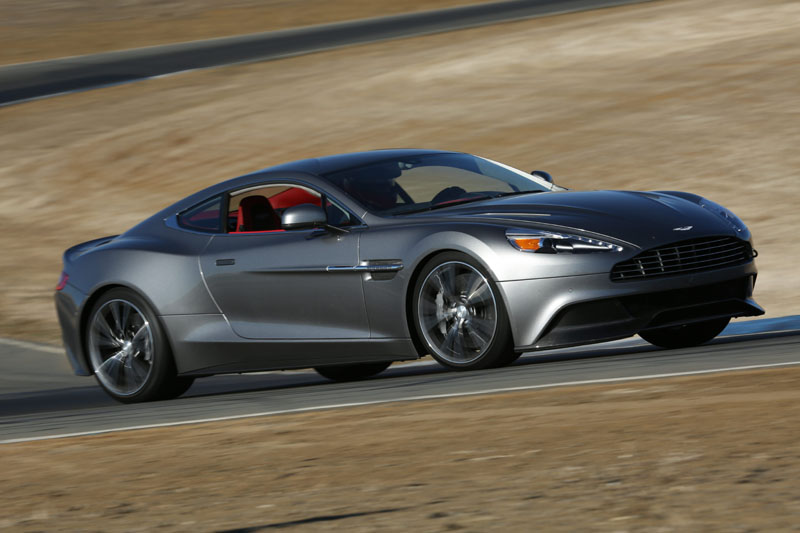 |
Bubba and the Professor At Play |
Regular readers will notice that we have reversed the stance put forth in the previous story, "Bubba and the Professor." We had decided only to picture the Vanquish from the rear, as part of the scenery, not to excite any negative reactions. Brother Danny pointed out, wearing his editorial hat, and Bubba and the Professor have come to agree, that the spirit of "sharing" that inspires these stories does not need to be concerned about those who are incapable of sharing the joys of others.
Regarding such dark souls, insert your own expletive of dismissal...
For Bubba and the Professor, our first experience on a racetrack was in the mid-'80s, at the Circuit Mont Tremblant in Quebec. We attended the Jim Russell Racing School (still operating, we are glad to note), one year for the Formula 1600 course, the next for the Formula 2000 class (with more power and aerodynamic wings that made the car a whole lot quicker and more serious - scary, even).
To readers with zero interest in motorsports, we promise to be as brief and considerate as possible. (After this latest trackday, we scribbled in our notebook, "Such an experience, such a scene, to try to describe - without being boring!) First of all, a roadrace track is different from the common stereotype of, say, a Nascar oval. Sometimes when we tell people we were at a trackday, they will say, "How fast did you go?" That's not what it's about. The typical layout might be two or three miles of loops and bends, a highly technical combination of turns in varying radii and camber, plus elevation changes (ups and downs). Short straightaways might allow you to accelerate beyond 100 mph for a few seconds, but then you'll be braking hard into the next turn, and balancing the car to take it as quickly as you can. On faster tracks, like Willow Springs, you carry a lot of speed through several bends, and have to brace yourself accordingly. After a long day of those "lateral Gs," we will hurt for days.
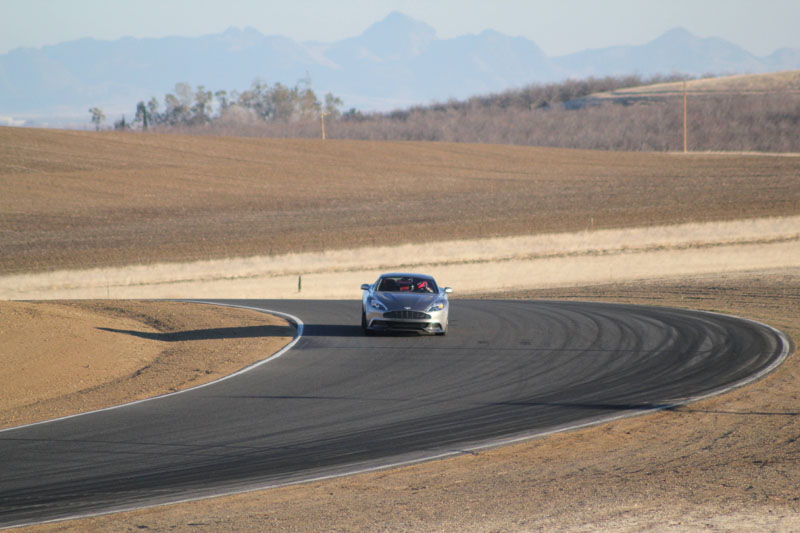 |
Off-Camber in a Dry Country |
On a trackday, there is no racing between drivers (or at least, not "officially"). The cars are sent out at intervals, with passing only permitted in specific "safe zones." You race against yourself and the track - which, unlike most public roads, is not designed to work for you, but against you. The tricks have names like "off-camber," meaning the corner banks away from you, or "decreasing radius," where a turn suddenly gets sharper instead of opening up. As you push your car, and its tires, to the limits of friction, smoothness is key - every input with hands and feet has to be "delicately deliberate." At best, it's a dance on the edge of control, and when you string together a series of smooth, fast laps, it feels very good.
Comparable to our drum studies - or early motorcycle training - the basics we learned at the beginning continued to be supplemented by other instructors. (For example, on two wheels, we attended the Freddie Spencer High Performance Riding School in Vegas, described in Ghost Rider. Which reminds us that we had another kind of split personality then - three ways, as we recall - traveling on that journey, and attending the school, under the alias John Ellwood Taylor.)
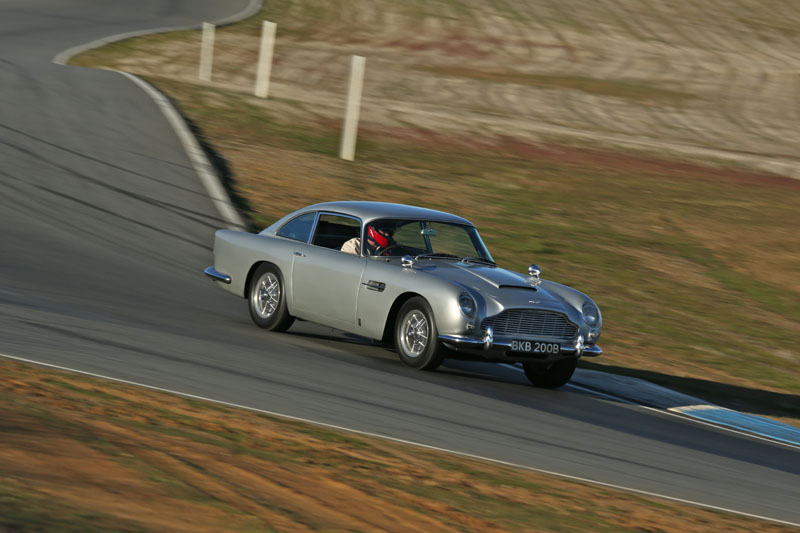 |
DB5 Storming Thunderhill, 2013 |
After moving to California in 2000, we discovered that informal trackdays for cars or bikes were common and inexpensive, and started attending one or two every year. (The Professor insisted that the risk of injury on a racetrack was too high on two wheels, so we stayed with cars.) Expert instructors were usually on hand, and we always liked to have them ride with us for a few laps - often in the early afternoon, after we'd had a chance to try it "our way" for a while. Inevitably they would give us enough little tips to make the rest of our day quicker, and raise our game for the next time.
Over the years we had the opportunity to challenge most of California's racetracks, like Laguna Seca, Willow Springs, the Auto Club Raceway in Los Angeles, and our favorite, Thunderhill Raceway in Northern California. The Aston Martin club event is always held there, and in January, when we are never touring (explained before, "Because, um, motorcycling?"), so we haven't missed one since 2006.
As always, this one was a learning experience. ("For research," again.) As we have moved up through successive modern Aston Martins, from the DB9 to the DBS, and now the Vanquish (the old DB5 was a one-time "parade" outing), we have to admit we have reached our peak of capability - maybe a little beyond. In one late morning session, we "overcooked" it on one corner, and the car went sliding sideways across the track (what Brit motojournalists would call a "lurid slide"). We corrected it enough to drive straight off into the dirt infield, rather than spinning, but as we went slewing into the dusty gravel (throwing up a mighty cloud of dust, we know from witnessing other "off-track excursions"), we were feeling plenty..."alert."
Trying to steer or brake would only make things worse, so it was necessary to counter that natural instinct. We just held on, mentally repeating, "Don't do anything, don't do anything," until the gravel slowed the car enough to let us steer back onto the track.
We made sure that didn't happen again. For the rest of the day we kept the car on the track, and reeled off some satisfyingly consistent laps.
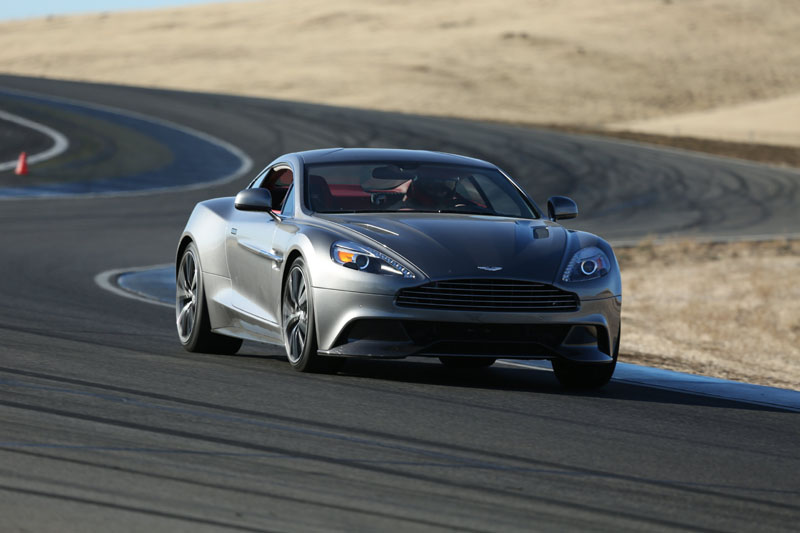
Bubba gets high on the adrenalin; the Professor likes the concentration and precision. They both have a very good time.
The longtime organizer of the Aston Martin event is George Wood, a district attorney up in the Bay Area. (We bought our DB5 from him, back in 2006.) In his DB9, George is a very enthusiastic participant himself, and once crowed, "I live for trackdays!"
Bubba and the Professor would almost agree - but between the two of us, we live for so many things. Cars, motorcycles, birds, words, music, landscapes, cooking, family, art, learning, roadtrips, and...single malt whisky.
After all these years, now that we are a sexagenarian, it's still rather amazing that we can find enough "common ground" to coexist. You could say the same about an enduring marriage (or rock band!), and perhaps the same qualities apply: we are just enough alike to be willing to share the same time and space, but different enough to sometimes surprise each other.

And here is a surprise testimonial from the past. Twenty years ago Andrew MacNaughtan collaborated on another portrait, for the Roll the Bones tourbook. We hoped it might represent what we vaguely felt were different facets of our character. Back then we weren't thinking of ourselves as Bubba and the Professor, but of course that's exactly what Andrew captured. The Professor held up Aristotle's Poetics, regarding the camera with a look of wry tolerance, or resignation, while in the background Bubba danced like a maniac.
That's us - I mean me.
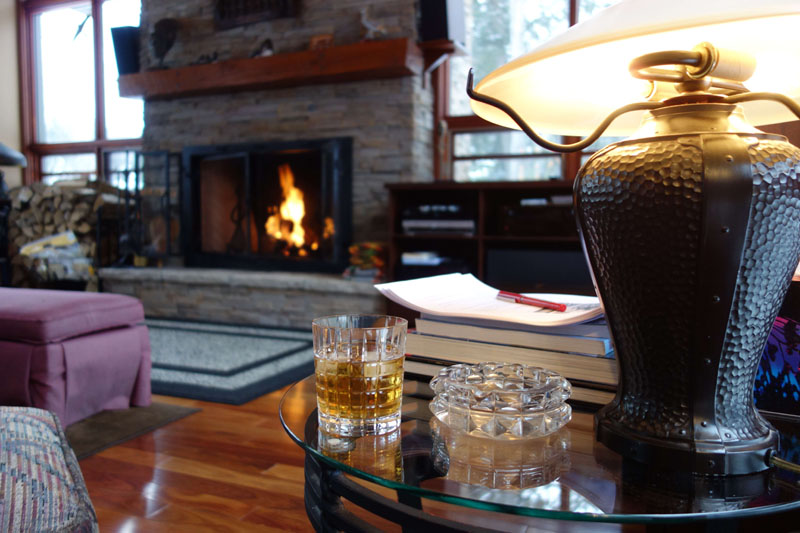 |
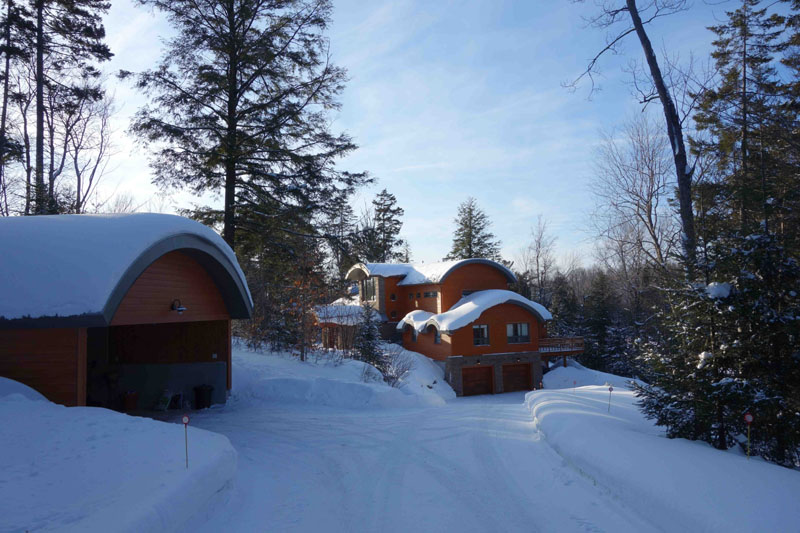 |
Bonus Picture - Bubba's Home |
When Bubba and the Professor were kids, it would have been Bubba who said, "I want to play the drums!"
The Professor would have replied, "Fine, but we're going to study and practice hard, and be as good as we can get. And never stop trying."
And so they united in a common goal. A few years later, it was Bubba who complained, "I want to quit school and be a full-time musician."
The Professor would have said, "Fine, but we're going to give it everything and more, even chase across the ocean and be poor and desperate, until we get established. Then we're going to get the education we're missing now."
Still later, Bubba said, "I want to ride motorcycles all over the place!"
The Professor said, "Fine, but we're going to learn to do it well, and wear all the proper gear, all the time. And I'll pick the destinations and routes - where we might learn something."
Some years passed, and Bubba said, "I want a '63 Corvette Sting Ray, like we used to dream of when we were ten! Remember how we used to draw that car all over our schoolbooks - until we started drawing Keith Moon's drumset instead?"
The Professor said, "Fine, but first we get an Aston Martin DB5 - because that's what we dream of now."
And so it came to pass that "on days like these," when the day starts to fade toward late afternoon, and it's time to pause and read over the day's work, you can always count on Bubba to say, "Hey Perfessor - how about a drink?"
The Professor will reply, "That would be nice, Bubba. I'll join you."